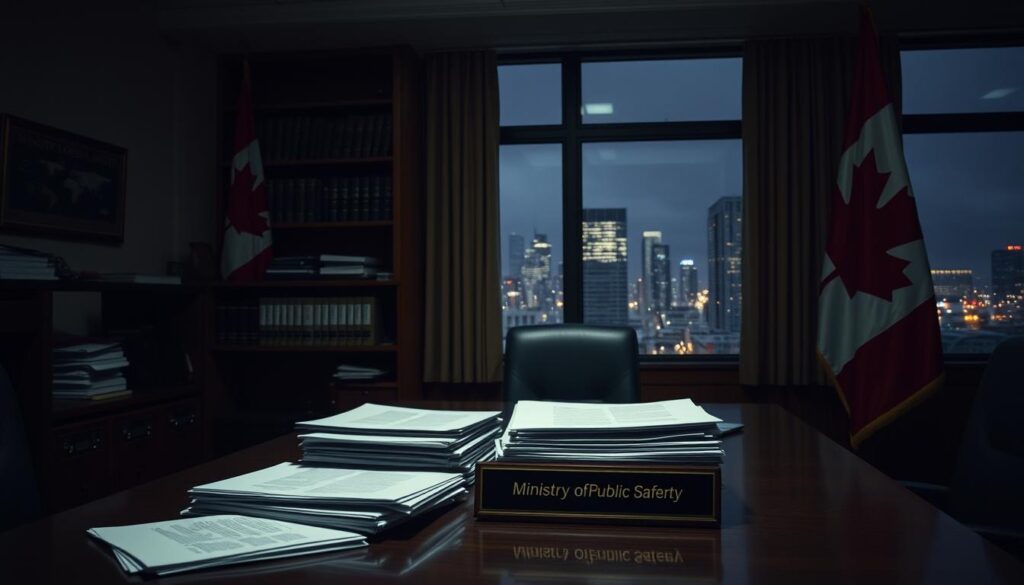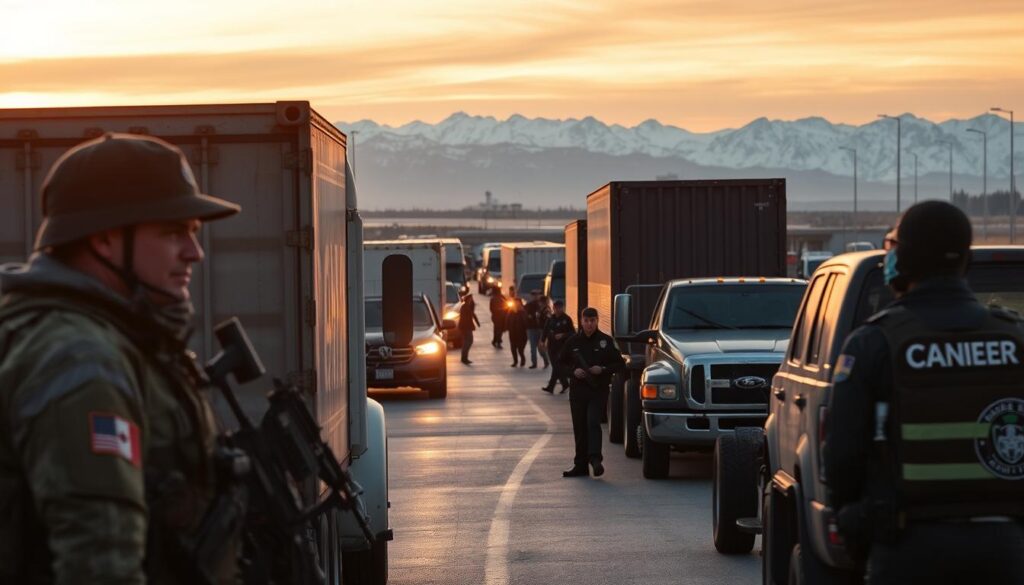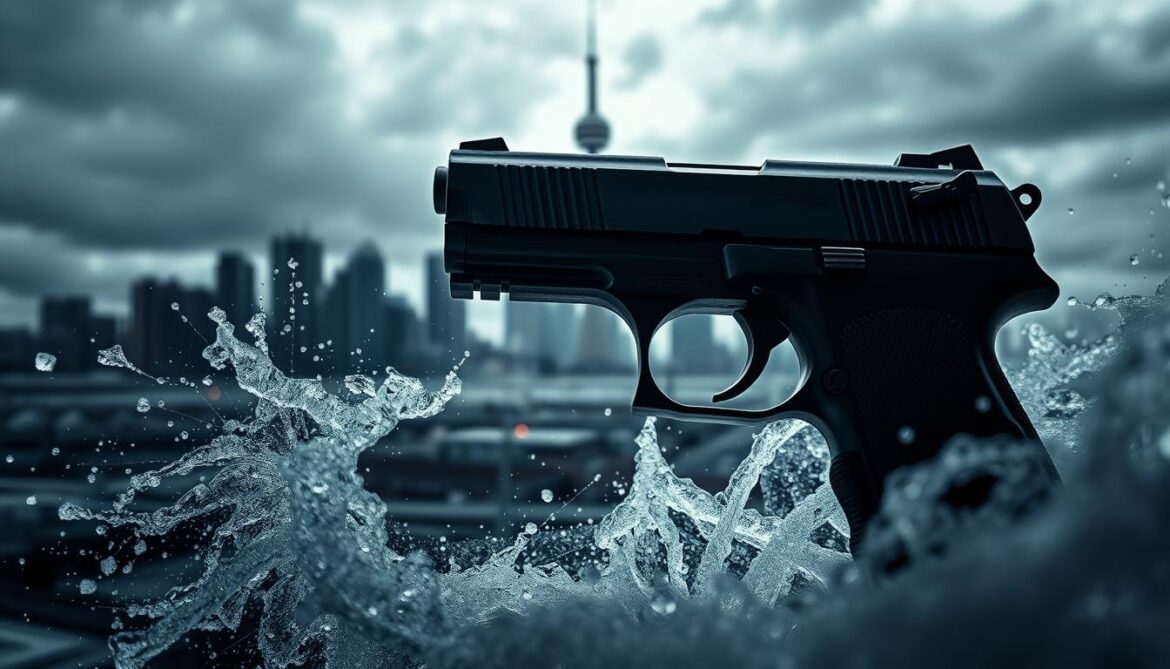Over 50% of violent firearm offenses in urban centers involved handguns before 2022. This alarming trend set the stage for Canada’s most significant firearms policy shift in decades. On October 21, 2022, Prime Minister Justin Trudeau announced a nationwide ban on purchasing, selling, or transferring restricted pistols. The decision followed years of escalating gun violence and public demands for action.
The freeze aims to reduce access to weapons often linked to street crime. Authorities argue fewer firearms in circulation could lower risks for communities. While existing owners retain their registered pistols, no new acquisitions are permitted. Importing restricted handguns also became illegal under the policy.
Public safety officials emphasize this measure complements broader strategies targeting smuggling and gang activity. Critics question its effectiveness, pointing to existing illegal firearms networks. Supporters highlight early data showing reduced handgun-related incidents in major cities since implementation.
Understanding this policy’s role in crime prevention requires examining its origins and goals. You’ll discover how it connects to national safety priorities and what changes might follow. The coming sections explore enforcement challenges, public reactions, and potential timelines for policy adjustments.
Overview of the Handgun Freeze and Its Impact on Canadian Crime
Between 2009 and 2020, nearly six out of ten violent firearm crimes involved compact weapons easily concealed in urban environments. This reality shaped legislative efforts to address public safety concerns through targeted measures.

Origins of Current Firearm Regulations
Canada’s firearm ownership rules evolved significantly after tragic events like the 2020 Nova Scotia attacks. Lawmakers prioritized limiting access to weapons frequently linked to street crimes. Registered owners retained existing pistols, but new acquisitions became prohibited under 2022 legislation.
Crime Data Analysis
Statistics Canada reports a five per cent drop in firearm-related violent offences between 2020 and 2021. Major cities drove this trend:
| City | Firearm Seizures (2022) | U.S.-Sourced Weapons |
|---|---|---|
| Toronto | 717 | 88% |
| Montreal | 421 | 79% |
| Vancouver | 338 | 82% |
While urban centers show progress, law enforcement emphasizes most illegal weapons originate from cross-border smuggling networks. Updated policies aim to disrupt these supply chains while addressing domestic stockpiles.
Governmental Policies and Legislation in Canada
Canadian policymakers reshaped firearm regulations through layered legal reforms. These changes aim to balance public safety with lawful ownership rights while addressing systemic risks.

Bill C-21 and the Handgun Freeze
Bill C-21 received royal assent in December 2023 after rigorous parliamentary debate. Key provisions include:
- 14-year maximum sentences for smuggling offenses
- Expanded domestic violence definitions covering all intimate partners
- Firearm bans for individuals under protection orders
“This legislation closes loopholes exploited by bad actors,” stated Public Safety Minister Marco Mendicino during the bill’s third reading. The law codifies existing restrictions while introducing stricter accountability measures.
Complementary Regulatory Measures
Additional policies strengthen the framework:
| Measure | 2022 Status | 2024 Update |
|---|---|---|
| Background Checks | 5-year renewals | Continuous screening |
| Red Flag Requests | Law enforcement only | Family members permitted |
| Exemptions Process | 90-day approval | 180-day review period |
Enhanced verification systems now flag high-risk applicants automatically. These changes align with broader crime prevention strategies targeting illegal firearms circulation.
Insights on Gun Control, Domestic Violence, and Crime Trends
Firearm access dramatically increases risks in abusive relationships. Research shows 33% of femicides involving abusers occur with guns. Updated policies now address this lethal connection through targeted legal mechanisms.

Correlation Between Firearm Access and Abuse Fatalities
Bill C-21’s expanded definitions now recognize coercive control as domestic violence. Chiefs can revoke licenses if someone may have engaged in stalking or abuse. This proactive approach removes weapons before tragedies occur.
Red flag laws let families request firearm removals. Combined with continuous background checks, these measures create multiple barriers for high-risk individuals. Early data reveals:
| Province | Protection Orders (2023) | Firearms Removed |
|---|---|---|
| Ontario | 1,412 | 297 |
| Quebec | 934 | 188 |
| British Columbia | 677 | 143 |
Shifting Patterns in Reported Violence
Major cities report 12% fewer intimate partner homicides since 2022. Non-fatal assaults involving guns dropped 18% during the same period. Researchers attribute this to restricted access and increased reporting options.
While overall violent crime rates remain stable, firearm-specific incidents show measurable declines. Experts emphasize these trends highlight how targeted gun control intersects with broader violence prevention strategies.
When will the handgun freeze end in canada
Canada’s national handgun sales suspension faces an uncertain future as political forces clash over its permanence. No expiration date exists for the measure, making its longevity dependent on electoral outcomes and policy priorities.
Government Projections and Policy Updates
Liberal leadership firmly supports maintaining restrictions. “Effective public safety requires limiting access to weapons that endanger communities,” stated a senior policy advisor during recent parliamentary hearings. Key factors influencing the freeze’s duration include:
- 2025 federal election results
- Cross-border smuggling reduction rates
- Urban crime statistics
| Party | Position | Policy Commitment |
|---|---|---|
| Liberal | Support | Permanent freeze |
| Conservative | Oppose | Repeal Bill C-21 |
Public and Industry Reactions to the Ban
Firearms retailers report 63% revenue declines since 2022, with some businesses closing permanently. Conversely, 74% of urban residents surveyed in March 2024 support continued restrictions according to Angus Reid polling.
Key stakeholder positions:
- Coalition for Gun Control: Advocates expanding the freeze
- Canadian Sporting Arms Association: Calls for Olympic athlete exemptions
- Police Chiefs Association: Supports combined enforcement strategies
Legal challenges from firearms groups remain pending, while provincial leaders debate localized enforcement approaches. This evolving landscape ensures ongoing national dialogue about balancing safety and rights.
Political Perspectives and the Public Debate on Gun Laws
Political leaders clash over strategies to curb firearm violence, exposing deep ideological divides. This conflict shapes how different parties address public safety through legislation. You’ll find stark contrasts in proposed solutions across the political spectrum.

Conservative vs. Liberal Approaches
Conservative Leader Pierre Poilievre argues existing policies miss their mark. “Criminals find weapons through smuggling networks, not legal channels,” he stated during a 2023 press conference. His party prioritizes border security upgrades and harsher penalties for traffickers.
Liberal Leader Mark Carney counters that restricting legal access prevents diversion to illegal markets. “Every weapon kept out of circulation makes communities safer,” he asserted in a parliamentary debate. The Liberals emphasize updated screening processes and red flag laws.
| Policy Focus | Conservative | Liberal |
|---|---|---|
| Primary Strategy | Border enforcement | Access restrictions |
| Key Proposal | Life sentences for traffickers | Expanded background checks |
| Funding Allocation | $1.2B for CBSA | $750M for police tracing |
Smaller parties propose alternative solutions. The NDP supports combined approaches, while the Bloc Québécois advocates provincial autonomy in enforcement. Public opinion polls show urban voters favor stricter laws, while rural residents prioritize lawful ownership rights.
Police organizations generally endorse measures targeting illegal firearms. However, frontline officers express concerns about resource allocation. These debates will likely intensify as parties refine their platforms ahead of federal elections.
Influence on Canadian Communities and Law Enforcement
Urban and rural regions experience contrasting realities under current firearm restrictions. Frontline officers face evolving challenges while balancing public expectations with operational limitations.
Law Enforcement Challenges and Border Security
The Toronto Police Association bluntly assessed recent measures: “Whatever you think you’ve done to improve community safety has not worked.” This criticism reflects frustrations with persistent illegal firearm circulation. Border agents seized 1,263 restricted weapons in 2023 – a 37% increase from 2021.

Enhanced screening technology at key crossings produced notable results:
| Border Point | 2021 Seizures | 2023 Seizures |
|---|---|---|
| Windsor-Detroit | 289 | 417 |
| Pacific Highway | 134 | 228 |
| Lacolle QC | 97 | 165 |
Surrey police leaders argue resources should target smuggling networks: “Criminals bypass legal channels entirely.” New detection tools help intercept shipments, but traffickers adapt routes constantly.
Community Safety and Public Sentiment
Urban centers report mixed reactions to firearm restrictions. Toronto residents expressed 58% support in recent surveys, while rural Albertans showed 73% opposition. These divides mirror differing exposure to gun violence.
Neighborhood watch programs expanded in Montréal and Vancouver. Community leaders emphasize prevention through youth outreach and mental health support. However, marginalized groups often feel overlooked in policy discussions.
Law enforcement agencies now collaborate more closely with social services. This integrated approach aims to address root causes while managing immediate risks. Ongoing debates question whether restrictions meaningfully improve daily safety for vulnerable populations.
Economic Implications and Firearms Industry Impact
Canada’s firearm restrictions have reshaped markets beyond public safety considerations. Businesses face financial strain as policies alter consumer access and operational models. Industry leaders report cascading effects across retail, manufacturing, and recreational sectors.
Repercussions for Retail and Manufacturing Sectors
Sporting goods stores lost significant revenue streams overnight. Wes Winkel of Ellwood Epps notes: “Handgun sales and accessories formed nearly a third of our business. Those profits vanished instantly.” The Canadian Sporting Arms Association predicts over 4,000 job losses by 2026 due to:
- Closed shooting ranges
- Reduced manufacturing output
- Fewer service providers
Delays in the government buyback program compound financial pressures. Businesses hold banned inventory without compensation timelines. Current amnesty extensions create uncertainty for retailers needing capital reinvestment.
| Sector | Revenue Drop (2022-2024) | Job Losses |
|---|---|---|
| Retail | 41% | 1,200+ |
| Manufacturing | 33% | 850+ |
| Training Facilities | 68% | 400+ |
Some companies pivot toward outdoor equipment or airgun sales. Others lobby for exemptions allowing limited transfer handguns between certified ranges. These adaptations buy time but rarely offset original earnings.
Conclusion
Canada’s firearm restrictions remain a cornerstone of efforts to curb urban violence while sparking nationwide debates. Current policies show measurable impacts: major cities report fewer incidents involving legally sourced weapons since 2022. However, challenges persist with smuggled firearms dominating crime statistics.
Political decisions will shape this legislation’s future. Supporters highlight reduced domestic violence risks through expanded red flag laws. Critics argue border security upgrades could yield better results. You’ll see continued tension between community safety priorities and lawful ownership rights.
Law enforcement agencies adapt strategies as illegal trafficking networks evolve. Enhanced screening at borders complements local initiatives targeting at-risk youth. Meanwhile, the buyback program’s delayed rollout leaves businesses in limbo.
This complex story balances immediate action against long-term solutions. Updated laws like Bill C-21 aim to keep weapons from dangerous hands. Yet lasting change requires addressing root causes – poverty, mental health, and systemic inequality – alongside regulatory measures.
FAQ
What is the current status of Canada’s national handgun freeze?
How does domestic violence relate to Canada’s firearm restrictions?
Have violent crime rates dropped since the handgun ban began?
What penalties apply for violating the handgun freeze?
How are communities reacting to the freeze?
What economic impacts has the freeze caused?
How does the freeze address illegal firearms?
FAQ
What is the current status of Canada’s national handgun freeze?
The national handgun freeze, enacted through Bill C-21 in October 2022, remains in effect indefinitely. It prohibits buying, selling, or transferring handguns within Canada. The federal government has not announced an end date, framing it as a permanent measure to reduce gun violence.
How does domestic violence relate to Canada’s firearm restrictions?
Research shows firearms are used in 82% of intimate partner homicides involving female victims. The freeze aims to curb access to handguns, which are often linked to domestic violence. Bill C-21 also expands background checks to flag risks like gender-based violence.
Have violent crime rates dropped since the handgun ban began?
Preliminary 2022 data indicates a 4% decline in violent crime involving firearms compared to 2021. However, law enforcement agencies like the Toronto Police report ongoing challenges with illegal weapons smuggled across borders, complicating trends.
What penalties apply for violating the handgun freeze?
Illegally selling or transferring restricted firearms can lead to up to 10 years in prison. Authorities prioritize prosecuting gun smuggling networks, with recent seizures at borders like Windsor-Detroit increasing by 46% year-over-year.
How are communities reacting to the freeze?
Urban centers like Montréal and Vancouver largely support stricter gun control, citing safety concerns. Conversely, rural groups and organizations like the Canadian Coalition for Firearm Rights argue the policy unfairly targets legal owners instead of tackling crime sources.
What economic impacts has the freeze caused?
Firearms retailers report revenue declines of up to 60%, with some closing stores. Manufacturers like Colt Canada face reduced demand, though the federal buyback program for assault-style weapons may offset losses long-term.
How does the freeze address illegal firearms?
While the freeze targets legal markets, law enforcement agencies stress that 85% of crime-linked guns originate from cross-border smuggling. Recent budgets allocated
FAQ
What is the current status of Canada’s national handgun freeze?
The national handgun freeze, enacted through Bill C-21 in October 2022, remains in effect indefinitely. It prohibits buying, selling, or transferring handguns within Canada. The federal government has not announced an end date, framing it as a permanent measure to reduce gun violence.
How does domestic violence relate to Canada’s firearm restrictions?
Research shows firearms are used in 82% of intimate partner homicides involving female victims. The freeze aims to curb access to handguns, which are often linked to domestic violence. Bill C-21 also expands background checks to flag risks like gender-based violence.
Have violent crime rates dropped since the handgun ban began?
Preliminary 2022 data indicates a 4% decline in violent crime involving firearms compared to 2021. However, law enforcement agencies like the Toronto Police report ongoing challenges with illegal weapons smuggled across borders, complicating trends.
What penalties apply for violating the handgun freeze?
Illegally selling or transferring restricted firearms can lead to up to 10 years in prison. Authorities prioritize prosecuting gun smuggling networks, with recent seizures at borders like Windsor-Detroit increasing by 46% year-over-year.
How are communities reacting to the freeze?
Urban centers like Montréal and Vancouver largely support stricter gun control, citing safety concerns. Conversely, rural groups and organizations like the Canadian Coalition for Firearm Rights argue the policy unfairly targets legal owners instead of tackling crime sources.
What economic impacts has the freeze caused?
Firearms retailers report revenue declines of up to 60%, with some closing stores. Manufacturers like Colt Canada face reduced demand, though the federal buyback program for assault-style weapons may offset losses long-term.
How does the freeze address illegal firearms?
While the freeze targets legal markets, law enforcement agencies stress that 85% of crime-linked guns originate from cross-border smuggling. Recent budgets allocated $1 billion to bolster border security and disrupt trafficking networks.
Are exceptions allowed under the handgun freeze?
Limited exemptions exist for elite sport shooters, security personnel, and Indigenous communities exercising treaty rights. All exceptions require approval from provincial chief firearms officers and federal regulators.
What role does the buyback program play in reducing gun violence?
The voluntary buyback program compensates owners of prohibited firearms, aiming to remove 150,000 assault-style weapons from circulation. Critics argue it lacks enforcement teeth, while proponents view it as complementary to the handgun freeze.
billion to bolster border security and disrupt trafficking networks.
Are exceptions allowed under the handgun freeze?
Limited exemptions exist for elite sport shooters, security personnel, and Indigenous communities exercising treaty rights. All exceptions require approval from provincial chief firearms officers and federal regulators.
What role does the buyback program play in reducing gun violence?
The voluntary buyback program compensates owners of prohibited firearms, aiming to remove 150,000 assault-style weapons from circulation. Critics argue it lacks enforcement teeth, while proponents view it as complementary to the handgun freeze.

